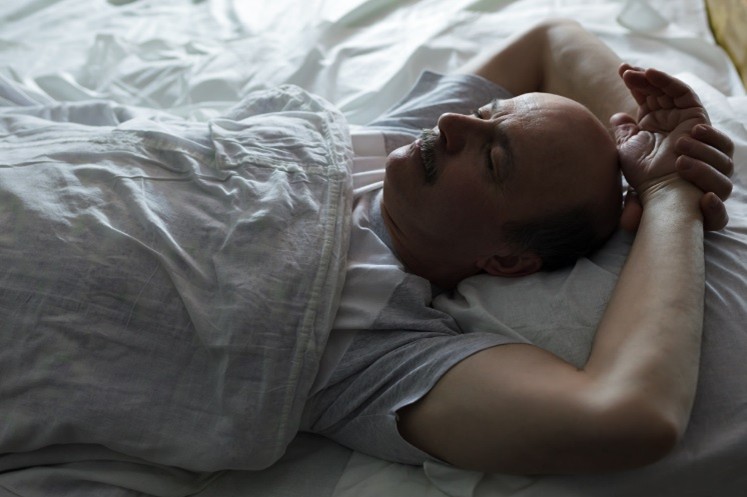Sleepwalking and Other Parasomnias

Parasomnias are a group of sleep disorders involving abnormal, unpleasant motor, verbal or behavioral events that occur during sleep or sleep transitions. (Singh 2018) Parasomnias include sleep-related disorders, such as sleepwalking, nightmares and sleep terrors. Many of these sleep-related experiences may be just mildly annoying, such as talking in your sleep or a child’s occasional nightmare. But in some cases, these conditions can potentially be very disruptive or disturbing, and they can be treated.
Parasomnias can occur at different stages of sleep—during rapid eye movement (REM) sleep, during non-REM sleep, and in transition between sleep and wakefulness. They are more common in children than adults but can occur at any age. Parasomnias often run in families. They are included among sleep disorders in the Diagnostic and Statistical Manual of Mental Disorders (DSM).
Parasomnias often appear as some mix of being asleep and being awake. The DSM notes that these conditions “serve as a reminder that sleep and wakefulness are not mutually exclusive, and that sleep is not necessarily a global, whole-brain phenomenon.”
One group of parasomnias, called non-REM sleep arousal disorders, occur during sleep-wake transition and involve sleepwalking or sleep terrors. When people sleepwalk, they typically have their eyes open with a blank stare and do not respond to others. They often wake up confused and do not remember the episode. Sleepwalking usually involves routine, uncomplicated activities and can involve eating (known as sleep-related eating disorder). Sleep terrors are extreme nightmares that usually last 30 seconds to 5 minutes. When a sleep terror ends, the person experiencing it wakes up in a fearful state, sitting up and often letting out a loud scream. The person usually doesn’t remember the dream or only remembers a little.
Nightmare disorder involves recurring intense, disturbing dreams that occur during REM sleep. The person recalls the dream in detail, unlike sleep terrors. They are typically associated with fear and anxiety, but can also involve anger, sadness or other unpleasant emotions. Nightmares can be caused by some medications, including antidepressants and hypertension medication.

Non-REM parasomnias are more common in younger people and are often outgrown by adulthood; REM parasomnias often begin in late adult life. About one in five adults experience sleepwalking and one in 10 experience sleep terror at some time in their lives. An estimated 2% to 8% of adults have a nightmare at least once a week. Men and women are equally likely to experience sleepwalking and sleep terrors, but women are more likely than men to have nightmares.
An estimated 10% to 30% of children have at least one episode of sleepwalking, and 10% to 50% have nightmares. However, fewer have the experiences frequently or are distressed by them.
Another parasomnia, REM sleep behavior disorder, involves people physically or vocally acting out their dreams during sleep. Because it can involve violent actions and can be dangerous for the person experiencing the violent dream and for his/her bed partner, it’s important to get treatment. The person is typically easy to wake up, wakes fully alert, and is able to remember the dream. However, many people with REM sleep behavior disorder aren’t aware of their behaviors during sleep and may only find out they have it when their bed partner or roommate tells them about their behavior. REM sleep behavior disorder is rare, affecting less than one percent of adults, most commonly older men. It can be a side effect of antidepressants or other medications.
Sleepwalking and sleep terrors usually occur in the first half of the night, while nightmares and REM sleep behavior disorders usually occur in the second half of the night.
What can you do?
Most children with parasomnias don’t need treatment and the episodes will become less frequent over time. For adults, a detailed sleep history by the patient and potentially by their bed partner is the initial step in a diagnosis. It is also important to identify and treat any comorbid sleep disorder (such as obstructive sleep apnea or restless leg syndrome) or other medical or mental health condition (such as nocturnal seizure disorder or posttraumatic stress disorder (PTSD)). An overnight sleep study or polysomnography (PSG) and video electroencephalography (EEG) are often useful in identifying parasomnias and other sleep disorders. For adults, good sleep habits, such as keeping a regular sleep schedule and routine, not becoming sleep-deprived, and managing stress can help improve symptoms. In some instances, therapy and medication can help.
Creating a safe environment for people with parasomnias can include sleeping on the lowest floor or not near a window, keeping nearby furniture to a minimum, or using child-proof doorknobs or door alarms. Household members should be aware of a person with parasomnias and what to do.
If you or someone you know has sleep-related activities that are potentially harmful or very disturbing or occur frequently, consider seeking help from a sleep specialist.
References
- American Psychiatric Association. 2022. Diagnostic and Statistical Manual of Mental Disorders, 5th edition, text revision (DSM-5-TR) used to diagnose mental illnesses.
- Singh S, Kaur H, Singh S, et al. (December 31, 2018) Parasomnias: A Comprehensive Review. Cureus. 10(12): e3807. DOI 10.7759/cureus.3807
- Haberlandt, E. Parasomnia in children and adults as a differential diagnosis to non-lesional focal epilepsy. Clinical Epileptology · Suppl 2 · 2023: S169-S175. https://doi.org/10.1007/s10309-023-00609-w.
- Fleetham JA, Fleming JA. Parasomnias. CMAJ. 2014 May 13;186(8):E273-80. doi: 10.1503/cmaj.120808. Epub 2014 May 5.
